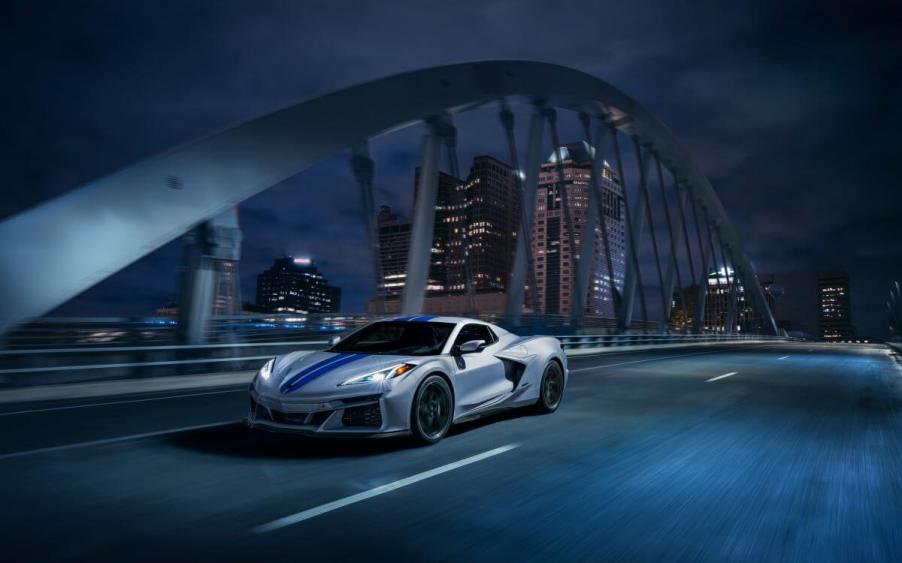
Is the Chevy Corvette E-Ray an EV?
It’s hard to find an automaker not moving to electrification these days. Every automaker is moving toward hybrid electric vehicles (HEVs) and battery electric vehicles (BEVs or EVs), including Chevrolet. The Bolt is Chevy’s most prominent EV, though the automaker is also adding EV versions of the Blazer, Equinox, and Silverado to its lineup soon. There’s also an electrified version of the Corvette called the E-Ray coming soon. However, is this new E-Ray really an EV or something else?
A look at the 2024 Chevy Corvette E-Ray
A new take on a classic sports car, the Chevy Corvette E-Ray is new for the 2024 model year. However, much about this new Chevrolet borrows from its namesake renowned pedigree. Well, it borrows more from the 2020 version of the ‘Vette, which some purists may not appreciate. The 2020 Corvette incorporates a mid-engine design and looks like a foreign exotic car, more so now than ever. The two-seater competes well with the likes of Lamborghini and Ferrari with a powertrain that produces 655 hp comfortably and can hit 60 mph in only 2.5 seconds, making it the quickest Corvette ever.
The E-Ray is available as both a convertible and a coupe. While it, like most cars in this segment, isn’t great for taller drivers, the E-Ray is designed to be very comfortable for those whom it fits. There are leather, metal, and suede interior option that look as good as they feel. The interior includes an 8.0-inch infotainment touchscreen, a 12.0-inch digital instrument display cluster, Bluetooth streaming, a mobile hotspot, and wireless Android Auto and Apple CarPlay.
Chevrolet notes the E-Ray will be available for a starting MSRP of $104,295 for the 1LZ coupe, while the 1LZ convertible will cost $111,295. That’s before upgrades and accessories, which include eight exterior and seven interior color choices, two carbon-fiber trim packages, three seating choices, five brake caliper choices, and more. However, with the growing appetite for EVs of all kinds, it’s important to understand whether the E-Ray truly fits the bill.
Is the E-Ray an EV or something else?
Despite the name, the 2024 Chevrolet Corvette E-Ray is not truly an EV. Instead, as Car and Driver notes, it’s an HEV that pairs the 6.2-liter V-8 engine in the Chevy Stingray with a 160-hp electric motor. The motor is positioned by and drives the front wheels, creating what Chevy calls e-AWD.
Beyond the combined 655-hp provided by the hybrid system, what’s also notable is that the E-Ray also includes a 1.1 kWh battery pack that allows drivers to hit 45 mph on electric power alone. Chevy calls this feature “Stealth Mode.” So, while the E-Ray can only travel this way for short distances, it’s a nifty trick nonetheless.
However, true electric vehicles lack an ICE and rely entirely on their electric motor system for full operations. HEVs pair an ICE with an electric motor system to improve a vehicle’s fuel economy and performance, decrease emissions, and increase marketability. Of course, with a name like “E-Ray” and words like “electrification” being thrown around a lot in its promo materials, it’s understandable why consumers may mistake the E-Ray for an EV. In fact, Chevy is banking on that confusion to lure prospective buyers to dealer lots. They figure that even if you have your heart set on an EV, it’ll be hard to say no to an E-Ray, especially after you take it out for a test drive.
Are other auto brands marketing ‘electrified’ vehicles this way?
While this marketing approach may not sit well with some consumers, Chevrolet is far from the only one practicing it. Indeed, the auto industry hasn’t engaged in a concerted campaign to clear up consumer confusion about EVs and HEVs. Many other brands are engaged in the same marketing tactics as Chevy.
A brand like Dodge or Jeep will launch a fancy press release and promotional events touting their newest “electrified models.” However, rather than launching EV versions of classics, the automakers will offer hybrid versions of those vehicles. The Dodge Hornet and Jeep 4xe lineup are prime examples. In both cases, the electrified versions were plug-in hybrids rather than full EVs.
Though it’s ethically dubious at best, it’s understandable that automakers would want to leverage every tactic they can to take advantage of the growing consumer appetite for EVs. EV adoption has been a slow burn in the U.S. until recently. Now, with interest spreading like wildfire, automakers are doing whatever they can to get drivers to take a test drive. However, one wonders how necessary such an approach truly is with a car with the quality engineering and prestige of the Corvette.



